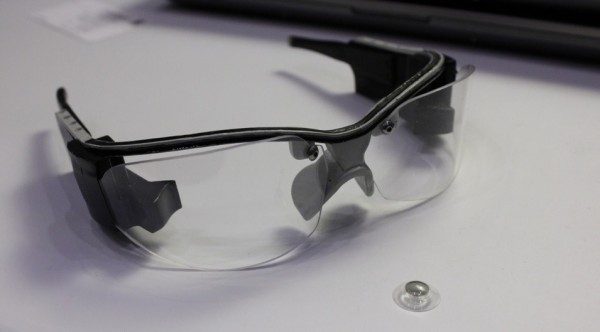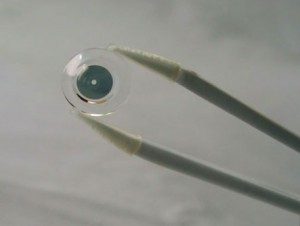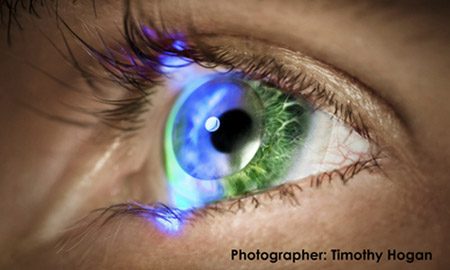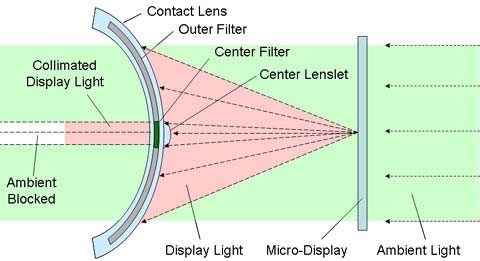The last time we heard from Innovega was back in April. They demonstrated their iOptik contact lens which allows users to focus their view on images that are extremely close to the eye. At CES 2013 last week, Innovega showed off it’s latest prototypes of the iOptik augmented reality system which combines contact lens with a low-profile head mounted display. The setup allows the creation of an AR display system which is compact but still retains a wide field of view.
iOptik Proof of Concept Video
Innovega recently released a short video which shows both the company’s near-future concept for the iOptik AR system and a demonstration of their existing technology:
Bulky Optics are a Challenge for Augmented Reality Eyewear
Traditionally the relationship between HMD bulk and field of view is inverse. Take the Oculus Rift, for example — huge field of view (90+ degrees), but also quite bulky. Then there’s Google Glass which is very compact, but has a small field of view, probably 20 degrees or so. Bulk might not be an issue for a virtual reality display, but augmented reality demands portability and something that you can wear in public without being laughed at.
The issue stems from the fact that humans have a hard time focusing on extremely close images. In order to fix this, you need lenses to re-focus incoming light. Innovega’s innovation is moving those potentially bulky lenses out of the eyewear and into the eye itself, in the form of a contact lens.
The company’s iOptik contact lenses refocus polarized light to the pupil which allows the wearer to focus on an image that is extremely close to the eye. The contacts can also include a user’s own eyewear prescription.
Now that the bulky optics have been eliminated, light-weight wearable displays can be used to project tiny augmented reality images onto the lens of the glasses. The projection, which would normally be impossible to focus on, comes into view with no problem thanks to the iOptik contacts. A large field of view (60 degrees or more, according to Innovega) can be maintained because the light source can be moved very close to the eye without losing focus. Innovega appears to working toward a field of view of nearly 120 degrees.
DVICE has an interview from CES 2013 with Innovega CTO, Randall Sprague:
The head mounted display that Innovega is using doesn’t appear to be their own — or at least not something that they’ll be putting up for sale. However, the company says that it offers a 1280×720 full-color display.

 Innovega’s work is funded by the U.S. Defense Advanced Research Projects Agency (DARPA). As such, the iOptik system is learning toward military use. The Verge reports that the company is currently sending hard-lens prototypes to military researchers. Innovega CTO, Randall Sprague, says that they’ll be sending a wearable prototype to DARPA this September.
Innovega’s work is funded by the U.S. Defense Advanced Research Projects Agency (DARPA). As such, the iOptik system is learning toward military use. The Verge reports that the company is currently sending hard-lens prototypes to military researchers. Innovega CTO, Randall Sprague, says that they’ll be sending a wearable prototype to DARPA this September.
In this latest outing however, the company seems to realize that there is broad consumer applications and growing interested in augmented reality technology. The Verge says that the company is now at work on a soft-lens for consumer AR use but it may still be a few years off. One cool thing about Innovega’s contact-based approach is that the contacts don’t cost any more to manufacture than typical prescription contacts. Of course the head mounted display is still needed which will make up the bulk of the cost.
For a contact lens that is an augmented reality display in and of itself, see here.








